Saturday August 23: Kashgar and Yarkand
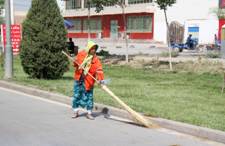 The drive to
Yarkand is about 200km and takes three hours, so we had an early start – not to
early to miss the Karakoram Café breakfast though! On the way out of Kashgar we
passed women sweeping the road with besom brooms; must be a bit daunting if the
road is long and straight.
The drive to
Yarkand is about 200km and takes three hours, so we had an early start – not to
early to miss the Karakoram Café breakfast though! On the way out of Kashgar we
passed women sweeping the road with besom brooms; must be a bit daunting if the
road is long and straight.
The route to Yarkand is largely gravel desert, though where you can get water, either from a river or an irrigation channel, you get villages, trees and crops such as maize, vegetables, and more especially, cotton. Many of the crops are sheltered from the intense sun by netting in a sort-of ‘inverse poly-tunnel effect’.
The first town of any size you pass through is Yengisar, and the speciality of the town is knives. All along the main road are knife factories, knife shops, and even knife museums – apparently the town is famous.
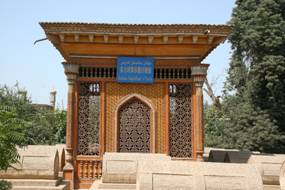
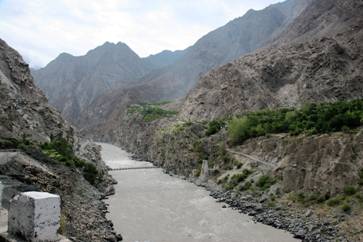 The
town of Yarkand itself was once the regional capital and is renowned for the
shrine of a famous 16th century poetess called Amannistan, and the
tombs of the 16/17th century kings. The shrine is quite beautiful.
The tombs are of a most distinctive shape, and have carvings either all over
them or only on the ends, and some are even painted. Some of the tombs are made
of stone, whilst others are essentially made of clay covered bricks. There are
a lot more tombs than I expected.
The
town of Yarkand itself was once the regional capital and is renowned for the
shrine of a famous 16th century poetess called Amannistan, and the
tombs of the 16/17th century kings. The shrine is quite beautiful.
The tombs are of a most distinctive shape, and have carvings either all over
them or only on the ends, and some are even painted. Some of the tombs are made
of stone, whilst others are essentially made of clay covered bricks. There are
a lot more tombs than I expected.
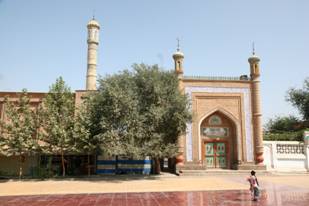 Yarkand also
has a mosque the Alun Mosque which is also famous in the region. Uighur mosques
principally consist of an open courtyard which there are often trees
(presumably for shade), and at one end there is an open canopied pavilion where
the Imam leads prayers and where the influential/local big-wigs pray. The
canopy is usually held up by painted wooden columns; often the paint is peeling
indicating some neglect though it can all look very picturesque. We wanted to
look round the mosque, but the guardian, who was a right misery, said it was
out of bounds to visitors till after the Olympics – I mean, did he think we
would come all that way to blow it up or something!
Yarkand also
has a mosque the Alun Mosque which is also famous in the region. Uighur mosques
principally consist of an open courtyard which there are often trees
(presumably for shade), and at one end there is an open canopied pavilion where
the Imam leads prayers and where the influential/local big-wigs pray. The
canopy is usually held up by painted wooden columns; often the paint is peeling
indicating some neglect though it can all look very picturesque. We wanted to
look round the mosque, but the guardian, who was a right misery, said it was
out of bounds to visitors till after the Olympics – I mean, did he think we
would come all that way to blow it up or something!
Both in Yarkand itself and on the return to Kashgar we saw many different forms of transport.
My observations suggest that there is a very definite hierarchy of personal/public transport:
· Private car – this may give lifts, though a fee will be expected
· Car-based taxi
· Big bus (some are air-conditioned)
· Minibus
· 3-wheeled tuc-tuc
· Horse and cart
· Camel cart
· Donkey cart
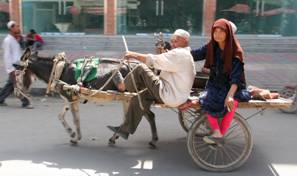
Scooters probably fit in underneath private cars, but they are essentially only used for around town journeys, and do not give lifts – though you often see a family of three (occasionally four) people on a scooter. Donkey carts are quite common and can often be seen taking whole families to market, especially to the Kashgar Sunday market.
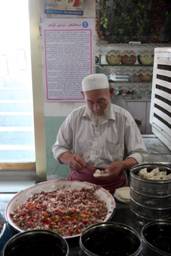
We ate lunch in what can only be described as an underground restaurant (I guess ‘restaurant’ is the right word – ‘underground’ it certainly was) by the main town square in Yarkand. It was absolutely heaving with people Sensibly we always let Quing Li do the ordering, and he never let us down, though there always seemed to be some problem that necessitated him going into the kitchen – it happened everywhere; perhaps he was just checking up that the hygiene was OK. We wondered about the hygiene in this place, but the food tasted alright, and we never got ill. It was interesting watching an old guy make sort-of apple dumplings which I liked but Margaret didn’t.
It is interesting to observe that although Pakistan and the Uighur area of China are both Muslim, they have completely different attitudes to women. In the North of Pakistan you almost never see women out in the streets whereas in the Kashgar area they are very common, not only that, but they hold down jobs, ride scooters and drive cars too.
However, in China there are interesting variations as to what the Muslim women wear:
· No head covering at all – the ‘modern way’ and surprisingly, more common in Yarkand than in Kashgar
· A small headscarf on the back of the head – much like you see in Poland and other parts of Eastern Europe; again, more common in Yarkand
· Normal large Muslim headscarf
· Head-to-toe burka leaving only the eyes showing – the most incongruous sight we ever saw was one such attired lady wearing designer sunglasses and high-heeled shoes
· Complete head-to-toe outfit with the head and eyes fully covered by a brown knitted hood
- not common, but much more common in Kashgar, and largely, but not exclusively, older women
Other communities such as the Tadjiks wear their traditional headgear.
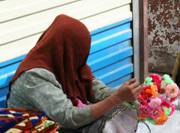
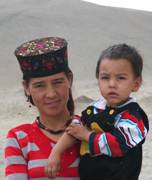
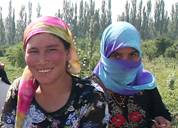
It was a long drive back to Kashgar, and that evening we had a ‘chinese’ meal in the restaurant by the hotel that is housed in the old British Consulate building. The stewed aubergines were particularly good. Quing Li disappeared into the kitchen again!